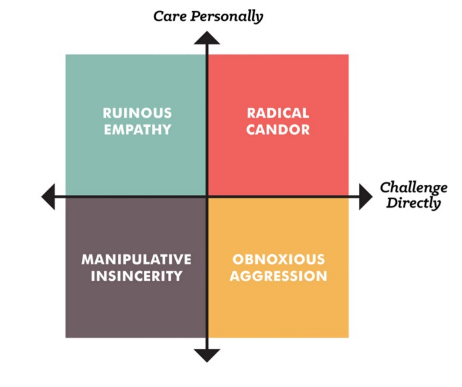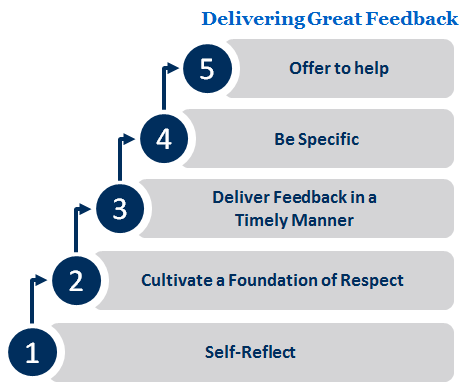As much as we accept that feedback and coaching are good, most people still feel awkward when giving and receiving feedback.
I was talking with fellow alumni from my grad school program and the conversation turned to performance management and feedback. These were people working at great companies. I was startled by how many questions they started asking me and it dawn on me that people are rarely trained on how to give feedback. Instead, people are usually guided by conventional wisdom or gut instinct.
Giving feedback without knowing what you are doing is like driving blind.

Before we get into what good feedback looks like, lets talked about the famed feedback sandwich:

Everyone knows the feedback sandwich. In theory it is great — most feedback tends to downplay what you are good at. However, it may offer a false sense of accomplishment that the content of your message is in fact valuable. At worst, the feedback sandwich protects someone from constructive feedback that would help them improve, not to mention someone at risk of losing their job.
Before I show you how to give world class feedback, lets talk about annual performance reviews.
The Drive to Eliminate the Annual Performance Review

This has not been a good year for the annual performance review. What do the following companies have in common?

You guessed it. Within the past three years, all of them have eliminated annual performance reviews. Why? Research from CEB (a best practice insight company) shows why this is happening:
“CEB found that 95 percent of managers are dissatisfied with the way their companies conduct performance reviews, and nearly 90 percent of HR leaders say the process doesn’t even yield accurate information” Source: Washington Post
However, lets not jump to conclusions. Many leading thinkers are railing against the annual performance review, but I think it may be getting a raw deal. It is likely a symptom of broader failed performance management systems and processes and likely not the root cause of the problems.
That doesn’t mean these companies are making the wrong move. This type of bold action is likely necessary to signal to their organization that they want to move in a new direction.
At the core of any effective organization there is a shared alignment around helping each other improve. Unfortunately, many organizations unconsciously support a culture of playing nice or passive aggressiveness that fails to enable self-improvement.
No one has broke this down better than Kim Scott, a former Googler who has championed a concept called “radical candor.” In a presentation to First Round Capital in 2015 (see video at end) she presented an intuitive framework:

Many people can quickly identify experiences where they have received feedback that falls in the yellow or green zone. This is what we want to avoid. Scott goes on in the video:
Radical candor is humble, it’s helpful, it’s immediate, it’s in person — in private if it’s criticism and in public if it’s praise — and it doesn’t personalize.” That last P makes a key distinction: “My boss didn’t say, ‘You’re stupid.’ She said, ‘You sounded stupid when you said um.’ There’s a big difference between the two.”
Now that may seem a little tough, but this type of approach can be effective — if it is grounded in a culture of respect and follows the principles I call out below:
The Five Elements of Great Feedback

1. Self-Reflection: “Know Thyself” is a great idea in theory, but hard to do in practice. Anyone who aspired to be great at coaching and feedback needs to start to separate what bothers them personally versus what will help another employee improve. Too many times, I have seen managers default to focusing on their own neurotic pet peeves. This leads to a lack of appreciation of other working styles and can lead to teams becoming more homogeneous and less creative. So ask yourself — Is this feedback I am about to give about me or will it really help this person improve? Everyone has two or three things that drive them crazy. It may be helpful to share these with the people you work with, but become aware of what percentage of your overall feedback and coaching focuses on these things.
2. Cultivate a Foundation of Respect: All feedback is built on a foundation of respect. The big mistake here is focusing on being well-liked versus building a strong relationship and embracing the concept of radical candor. The easiest way to develop a strong rapport with colleagues is to get to know them. Crazy! I know — but many people do not take this step. Take the effort to ask what others are working on, what they think they are good at and what you can do to help them generally or on a specific project. When it comes time to offer timely feedback (see next step) you will already have a strong relationship to build on. One thing I do with people when I first start working them is ask “How do you like to get feedback?” and “What are you trying to improve on?” I also share my personal preferences which shows that I am open and looking forward to them helping me improve as well.
3. Timely: Most feedback fails on this point. If you are receiving feedback in December about a phone call you made in September, this will just make you resent the person for not telling you at the time. This person really was afraid to be honest and you’ll lose faith that the person wants to see you improve. If it’s not a cultural norm, you need to be proactive to seek out timely feedback. For example, anytime I give a public presentation I always ask one audience member to give me feedback. I always specify two or three specific things I am working on so that they know what to look for. Without someone proactively asking for feedback, I typically ask them, Would you like feedback on X? immediately after the observed action. Most people happily say yes.
4. Specific: Giving someone the feedback that “sometimes you do X” is not helpful. Be specific and use examples when giving someone feedback, especially if it refers to an event in the past. Specific feedback should sound something like this: “I noticed you spoke in a quiet voice when speaking on Tuesday. It could help you appear more confident if you worked on communicating with more energy.”
5. Next Steps / An Offer to Help: While working at McKinsey, we were trained on giving feedback. One of the impressive things was that people I worked with always made an offer to help with next steps. Building on the last example, you will notice that the person offered an observation about someone’s energy level but offered no plan for how to actually change and improve. A better offer could be: “I noticed you spoke in a quiet voice when speaking on Tuesday. It could help you appear more confident if you worked on communicating with more energy. I’m happy to observe your next talk and provide feedback on your progress. I’d also suggest watching Eric speak and asking him for advice, he is very good at this”
So next time you are giving feedback to someone ask yourself:
- Do I really care about this person’s improvement?
- Is this feedback on something that they can control?
- Is the feedback timely and specific?
- Have I made an offer to help them act on the feedback?
Watch Kim Scott’s Radical Candor video here: